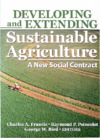Soil Health
Soil health is defined as the continued capacity of soil to function as a vital living ecosystem that sustains plants, animals, and humans. Creating and maintaining a healthy soil is more than just reducing erosion. The benefits of a healthy soil go far beyond crop production.
Five Soil Health Principles of NRCS
The USDA Natural Resources Conservation Service (NRCS) has identified four principles for improving soil health and sustainability:
- Use plant diversity to increase diversity in the soil.
- Manage soils more by disturbing them less.
- Keep plants growing throughout the year to feed the soil.
- Keep the soil covered as much as possible.
- Integrate livestock to recycle nutrients and increase plant diversity.
A healthy soil has good water infiltration and retention. The biological activity within the soil increases soil fertility and helps build good soil structure. These things reduce the need for expensive inputs and increase plant resilience to drought, pests and intense rains.
Agroforestry’s Role in Soil Health
Because agroforestry systems include trees and shrubs, as well as other perennial vegetation, they support each of the four soil health principles. Incorporating trees and shrubs into annual cropping systems increases root diversity that feeds the living organisms within the soil. Perennial plants often require less soil disturbance and have roots growing through a greater part of the year. Perennial living cover also helps protect the soil from wind and water erosion which helps in building and maintaining good soil structure.

Agroforestry systems can complement other practices that improve soil health like cover crops, no or low till, nutrient management, or crop rotation. These practices can work together to provide the best protection for your soil. They also can support one another so that if one fails, others are still in place. For example, if a cover crop fails to get well established because of drought or frost, agroforestry systems still provide living cover on the landscape.
Agroforestry is not the only way to create and maintain healthy soil, but agroforestry supports soil health and more.
Soil Health Publications
Information Sheets
Infosheet

Infosheet

Infosheet

Brochures
Inside Agroforestry
Inside Agroforestry

Inside Agroforestry

Inside Agroforestry

Inside Agroforestry

Agroforestry Notes
Agroforestry Note

Windbreaks And Hedgerows In Vineyards
DownloadAgroforestry Note

Silvopasture In Vineyards
DownloadAgroforestry Note

Alley Cropping In Vineyards
DownloadAgroforestry Note

Silvopasture: An Agroforestry Practice
DownloadAgroforestry Note

Forest Farming: An Agroforestry Practice
DownloadAgroforestry Note

Windbreak Density: Rules Of Thumb For Design
Download
Research
Research

Carbon Dynamics Of Silvopasture Systems In The Northeastern United States
DownloadResearch

Assessing Silvopasture Management As A Strategy To Reduce Fuel Loads And Mitigate Wildfire Risk
DownloadResearch

Enhancing Ecosystem Services: Designing For Multifunctionality
DownloadResearch

Creatively Communicating Conservation Complexity
DownloadResearch

Developing And Extending Sustainable Agriculture: A New Social Contract
DownloadResearch

Precision Conservation In North America
DownloadResearch

Computer-based Tools For Decision Support In Agroforestry: Current State And Future Needs
DownloadResearch

Alteration Of Soil Water Content Consequent To Root-pruning At A Windbreak/crop Interface In Nebraska, USA
DownloadResearch

Ecobelts: Reconnecting Agriculture And Communities
DownloadResearch

Ecobelts: Reconnecting Agriculture And Communities - Case Studies
DownloadResearch

Evaluation Of A Collaborative Model: A Case Study Analysis Of Watershed Planning In The Intermountain West
DownloadResearch

An Ecological Foundation For Temperate Agroforestry
Download

























